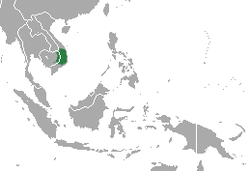| Douc [1] | |
|---|---|
 | |
| Red-shanked douc (Pygathrix nemaeus) at the Philadelphia Zoo | |
| Scientific classification | |
| Kingdom: | Animalia |
| Phylum: | Chordata |
| Class: | Mammalia |
| Order: | Primates |
| Suborder: | Haplorhini |
| Infraorder: | Simiiformes |
| Family: | Cercopithecidae |
| Subfamily: | Colobinae |
| Tribe: | Presbytini |
| Genus: | Pygathrix É. Geoffroy, 1812 |
| Type species | |
| Simia nemaeus Linnaeus, 1771 | |
| Species | |
See text | |
The doucs or douc langurs make up the genus Pygathrix. They are colobine Old World monkeys, native to Southeast Asia, consisting of 3 species: red-shanked douc, black-shanked douc, and gray-shanked douc.









